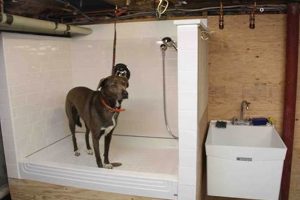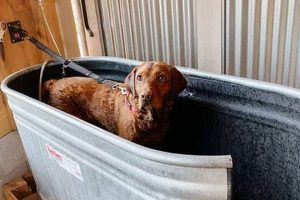The act of constructing an enclosure for canine containment using primarily self-sourced materials and personal labor is a significant undertaking for many pet owners. For instance, a property owner might choose to assemble a barrier from wood and wire mesh instead of purchasing a pre-fabricated system.
Such a project offers potential cost savings and customization options when compared to professional installation or pre-built solutions. Historically, property owners have employed various methods to contain animals, evolving from simple barricades to more sophisticated structures. This approach to pet management grants greater control over design and materials, suiting specific needs and aesthetic preferences.
The following sections will detail essential considerations for planning and executing a successful project, covering material selection, installation techniques, and safety protocols to ensure a secure and effective boundary.
Essential Guidance for Enclosure Construction
The subsequent recommendations aim to provide practical advice for those undertaking the construction of a canine containment system. Adherence to these guidelines promotes a safer, more effective, and aesthetically pleasing result.
Tip 1: Precise Perimeter Planning: Prior to any physical labor, meticulously map the desired boundary. Accurate measurements and clearly defined corners are critical for material estimation and fence alignment.
Tip 2: Ground Assessment is Paramount: Examine the soil composition along the intended fence line. Rocky or uneven terrain necessitates specialized anchoring techniques to ensure stability and prevent gaps.
Tip 3: Material Selection Reflects Canine Behavior: Choose durable materials appropriate for the dogs size, breed, and temperament. Robust breeds may require sturdier fencing than smaller, less active dogs.
Tip 4: Post Integrity is Non-Negotiable: Properly set fence posts are foundational to a secure barrier. Deep post holes, concrete reinforcement, and proper post spacing prevent leaning or collapse.
Tip 5: Consider Ingress and Egress Points: Integrate secure gates with reliable latches. Gate placement should optimize yard accessibility and minimize escape opportunities. Regularly inspect gate hardware for wear and tear.
Tip 6: Burrow Prevention Measures: For dogs prone to digging, consider burying wire mesh along the base of the barrier. This deters subterranean escapes and protects the fence integrity.
Tip 7: Periodic Inspection and Maintenance: Regularly inspect the entire structure for damage, loose connections, or potential weaknesses. Promptly address any issues to maintain effectiveness and longevity.
These guidelines emphasize the importance of careful planning, appropriate material selection, and consistent maintenance. Diligent application of these principles significantly increases the likelihood of creating a secure and reliable enclosure.
The following section will delve into specific material options and their suitability for various applications.
1. Perimeter Security
Perimeter security, in the context of constructing a canine containment system, represents the primary objective: preventing the animal’s escape. When undertaking such a project, compromises on perimeter integrity can lead directly to the system’s failure, rendering it ineffective. The design and construction choices directly impact the barrier’s ability to withstand the dog’s attempts to breach it. For instance, a fence constructed with insufficient height may be easily jumped by larger breeds, whereas inadequate anchoring allows determined canines to dig underneath. The effectiveness of this canine containment effort is thus directly proportional to the strength and design of perimeter security measures.
Practical applications of perimeter security principles include selecting appropriate fence height and material based on the dog’s breed and temperament. Implementing subterranean barriers, such as buried wire mesh, is a direct response to the burrowing behavior of certain breeds. Furthermore, ensuring that all fence connections are secure and that gates are equipped with reliable locking mechanisms are essential components. Another approach can involve using electric fences. These offer a non-physical barrier that can deter dogs from approaching or attempting to cross the established boundary. These options are used as practical methods and are necessary for an effective structure.
In summary, prioritizing perimeter security is not merely a design consideration but the foundational principle upon which the overall success of a canine containment project hinges. The challenge lies in correctly assessing the dog’s capabilities and vulnerabilities and then translating those assessments into tangible design features. Attention to perimeter security ensures a durable and reliable containment system, preventing the animal from escaping and mitigating potential risks associated with a dog roaming freely. It highlights its critical role in a broader goal.
2. Material Durability
Material durability is a central consideration when undertaking a canine enclosure project. The selection of materials directly impacts the longevity, security, and overall effectiveness of the barrier. This choice must account for environmental factors, canine behavior, and budgetary constraints.
- Resistance to Environmental Degradation
Material choice must factor in local climate conditions. Wood, for instance, is susceptible to rot and insect damage in humid environments, necessitating pressure treatment or naturally resistant species like cedar. Metal options, such as chain-link or welded wire, require galvanization or powder coating to prevent rust. Polymeric materials, while resistant to moisture, may degrade under prolonged UV exposure, requiring UV stabilizers. Failure to account for environmental factors leads to premature failure of the barrier.
- Withstanding Canine-Induced Stress
The material must withstand the physical stress imposed by the dog. Large or energetic breeds may test the fence’s integrity through jumping, leaning, or digging. Thin-gauge wire or brittle plastics are inadequate for such scenarios. Reinforced materials, such as heavy-gauge metal mesh or thick wooden planks, offer greater resistance to physical damage. The materials must be chosen with a clear understanding of how the dog tests the integrity of the enclosure.
- Maintenance Requirements
Material selection influences the required upkeep. Wood requires periodic sealing or painting to prevent decay and maintain aesthetics. Metal fencing may require occasional rust removal and protective coating application. Polymeric materials generally require less maintenance but are susceptible to cracking or fading over time. Considering the long-term maintenance burden is crucial for making informed material choices. Ease of repair is a key factor in selecting a material.
- Cost-Benefit Analysis
A balance must be struck between initial material cost and long-term durability. Lower-cost options may require more frequent replacement or repairs, ultimately negating any initial savings. Conversely, premium materials offer enhanced durability and reduced maintenance but involve a higher upfront investment. A comprehensive cost-benefit analysis considers the lifespan of the fence, projected maintenance expenses, and the potential consequences of fence failure.
The selection of durable materials is a foundational aspect of constructing a reliable and long-lasting canine containment system. A detailed understanding of environmental factors, canine behavior, maintenance requirements, and cost considerations informs the choice, ensuring that the enclosure effectively contains the animal while minimizing long-term maintenance and replacement costs.
3. Post Stability
Post stability is a critical determinant of the overall success and longevity when self-constructing a canine barrier. It directly influences the fence’s ability to withstand environmental stresses, resist canine-induced forces, and maintain its structural integrity over time. A lack of post stability precipitates a cascade of negative consequences, undermining the barrier’s purpose. For example, inadequately secured posts will lean or uproot, creating gaps that allow the dog to escape. High winds and soil erosion exacerbate the problem, accelerating fence degradation and necessitating costly repairs.
Proper post installation techniques are, therefore, paramount. This includes selecting posts of appropriate material and dimensions based on the anticipated load and soil conditions. Deeper post holes and the use of concrete reinforcement significantly enhance stability, particularly in areas with loose or unstable soil. Correct post spacing also plays a role, preventing excessive strain on individual posts. Consider, for instance, a homeowner who builds a wooden fence for their large dog. If the posts are set only a foot deep in sandy soil, the dog leaning against the fence is highly likely to loosen the posts over time, leading to sagging and eventual failure. In contrast, if the same homeowner uses metal posts, sets them three feet deep in concrete, and spaces them appropriately, the fence will be significantly more durable and effective at containing the animal.
In summary, achieving post stability is not merely a technical detail; it is a fundamental requirement for a durable and reliable canine enclosure. Neglecting this aspect compromises the entire structure, increasing the risk of escapes and escalating maintenance costs. Therefore, meticulous attention to post installation techniques is essential for any successful barrier project. The expense of concrete and additional labor during installation is small compared to the cost of repeatedly repairing a poorly constructed fence.
4. Burrow Prevention
Burrow prevention constitutes a critical element within the domain of self-constructed canine enclosures. The propensity of certain dog breeds to dig undermines the integrity of any fence system, irrespective of its surface-level robustness. Therefore, effective containment necessitates proactive measures to thwart subterranean escape attempts. The omission of burrow prevention strategies when undertaking a “dog fence diy” project renders the entire endeavor vulnerable to failure. The link between the two is direct: burrowing behavior is a potential breach, and preventive construction methods are the mitigation.
Various techniques serve to impede burrowing. One common approach involves extending the fence material below ground level, creating a physical barrier that discourages digging. For example, burying wire mesh or chain-link fencing along the base of the fence line presents a formidable obstacle to determined diggers. Alternatively, a concrete footing poured along the perimeter provides an impenetrable barrier. The selection of a specific method depends on factors such as soil composition, budget constraints, and the dog’s digging persistence. A clay soil may be more effectively addressed with a simple buried mesh, while a sandy soil requires a more substantial concrete footing to prevent erosion and subsequent undermining. The specific circumstances inform the solution.
In conclusion, integrating effective burrow prevention strategies is indispensable for the success of a “dog fence diy” project. By addressing the inherent digging instincts of canines, constructors enhance the overall security and longevity of the enclosure. Failure to consider burrowing risks compromising the entire system, resulting in potential escapes and necessitating costly repairs. Therefore, proactive planning and implementation of appropriate preventive measures are essential investments for responsible pet ownership. The lack of such considerations is a predictable failure point.
5. Gate Mechanisms
Gate mechanisms represent a crucial, often overlooked, component of any self-constructed canine containment system. The gate serves as the primary point of entry and exit, and its security directly influences the overall effectiveness of the enclosure. A poorly designed or inadequately secured gate mechanism can compromise the entire structure, rendering the rest of the enclosure largely irrelevant.
- Latch Security and Reliability
The latching mechanism must be robust and resistant to accidental or intentional opening by the dog. Simple hook-and-eye latches are often insufficient, particularly for intelligent or persistent breeds. Self-latching mechanisms, gravity latches, or those incorporating a locking pin offer increased security. Regular inspection and maintenance of the latch are essential to ensure continued reliability. For example, a gate with a spring-loaded latch provides automatic closure and security, preventing accidental escapes if left unlatched momentarily.
- Hinge Strength and Placement
Hinges must be capable of supporting the weight of the gate and withstanding repeated use. Heavy-duty hinges, securely fastened to both the gate and the fence post, are critical. Hinge placement affects the gate’s swing and ease of operation. Consider using multiple hinges for wider or heavier gates to distribute the load. Furthermore, the hinge design should minimize the potential for a dog to manipulate or damage it. Exposed hinge pins can be a vulnerability, necessitating the use of tamper-resistant hardware.
- Gate Frame Integrity
The gate frame must be structurally sound to prevent warping, sagging, or damage. Welded metal frames provide superior strength and durability compared to wooden frames, which are susceptible to rot and insect damage. Ensure the frame is properly aligned and square to facilitate smooth operation and secure latching. Reinforcing the corners of wooden frames with metal brackets increases their longevity. The materials must be durable enough to withstand normal wear.
- Clearance and Ground Contact
Adequate clearance between the gate and the ground is necessary to prevent dragging or binding. However, excessive clearance creates a potential escape route for smaller dogs. A small gap, approximately one to two inches, is generally recommended. Consider the terrain’s slope when determining the necessary clearance. For example, on uneven ground, the gate might require a larger gap at one end to swing freely. The gap has to minimize any potential to escape from the perimeter of the canine containment area.
Proper gate design and installation are crucial in the context of “dog fence diy”. These detailed steps emphasize the interconnectedness of each element of the fence system. Any weakness in the gate mechanism presents a vulnerability that a determined canine will likely exploit. Therefore, paying close attention to latch security, hinge strength, frame integrity, and ground clearance is essential for creating a secure and effective canine containment system.
Frequently Asked Questions
The following questions address common concerns and misconceptions regarding the self-construction of canine containment systems. The answers provide guidance based on established best practices.
Question 1: Is it permissible to use inexpensive materials for a canine enclosure to minimize costs?
The employment of low-cost materials in canine enclosure construction warrants careful consideration. While cost savings are attractive, the long-term durability and security of the barrier are paramount. Compromising on material quality can lead to premature failure, necessitating frequent repairs or replacement, thereby negating initial savings. The suitability of materials is dependent on the canine’s breed, size, and temperament, alongside environmental factors.
Question 2: How vital is professional experience for constructing a functional canine enclosure?
Prior professional experience in construction or related trades is beneficial but not strictly mandatory. However, a thorough understanding of basic construction principles, proper tool usage, and safety protocols is essential. Individuals lacking such experience should consult instructional resources, seek guidance from experienced individuals, or consider enrolling in relevant training programs to mitigate potential risks and ensure structural integrity.
Question 3: Are subterranean barriers invariably required for all canine enclosures?
Subterranean barriers are not universally required but are strongly recommended, particularly for breeds predisposed to digging or inhabiting areas with soft, easily excavated soil. The absence of a subterranean barrier constitutes a significant vulnerability, potentially enabling the canine to escape beneath the fence line. The specific type and depth of the barrier should be tailored to the dog’s digging behavior and soil conditions.
Question 4: Can an electric fence serve as the sole means of canine containment?
The viability of an electric fence as the sole containment method depends on several factors, including the dog’s temperament, training, and pain tolerance, in addition to local regulations. Electric fences are most effective when used in conjunction with behavioral training, teaching the dog to respect the boundary. Caution is advised, as some dogs may disregard the electrical stimulus, rendering the system ineffective. Furthermore, local ordinances may restrict or prohibit the use of electric fences in certain areas.
Question 5: How frequently should a self-constructed canine enclosure be inspected for potential vulnerabilities?
Regular inspection is crucial for maintaining the security and integrity of any canine enclosure. A comprehensive inspection should be conducted at least monthly, with more frequent inspections during periods of inclement weather or after significant events, such as storms or attempted breaches. The inspection should encompass all components, including posts, fencing material, gates, latches, and subterranean barriers, identifying and addressing any signs of damage, wear, or potential weaknesses.
Question 6: What recourse exists if a canine successfully breaches a self-constructed enclosure?
In the event of a breach, immediate action is required to secure the canine and prevent further escapes. The enclosure should be thoroughly inspected to identify the point of failure, and corrective measures implemented promptly. This may involve reinforcing vulnerable areas, repairing damaged components, or modifying the design to address the specific breach. Furthermore, the canine’s behavior should be assessed to determine the underlying cause of the escape, enabling targeted behavioral interventions to prevent future occurrences.
The preceding responses offer guidance for common inquiries relating to the independent erection of pet containment systems. Careful deliberation is crucial in ensuring animal safety and security.
The ensuing section will address recommended tools and equipment for “dog fence diy” projects.
Dog Fence DIY
The preceding discussion has explored multiple facets of constructing a canine enclosure without professional assistance. Key considerations include material selection, structural integrity, burrow prevention, gate security, and ongoing maintenance. Each element contributes directly to the system’s effectiveness in safely containing the animal and mitigating potential risks to the surrounding environment.
Successfully executing “dog fence diy” necessitates a comprehensive understanding of both the project’s technical demands and the canine’s specific behavioral characteristics. It is a serious undertaking, demanding thorough planning, diligent execution, and a commitment to ongoing evaluation and improvement. The result, when approached with due care and attention, is a secure environment that benefits both the animal and the community. Failure to prioritize these factors represents a dereliction of responsibility and can have significant consequences.







